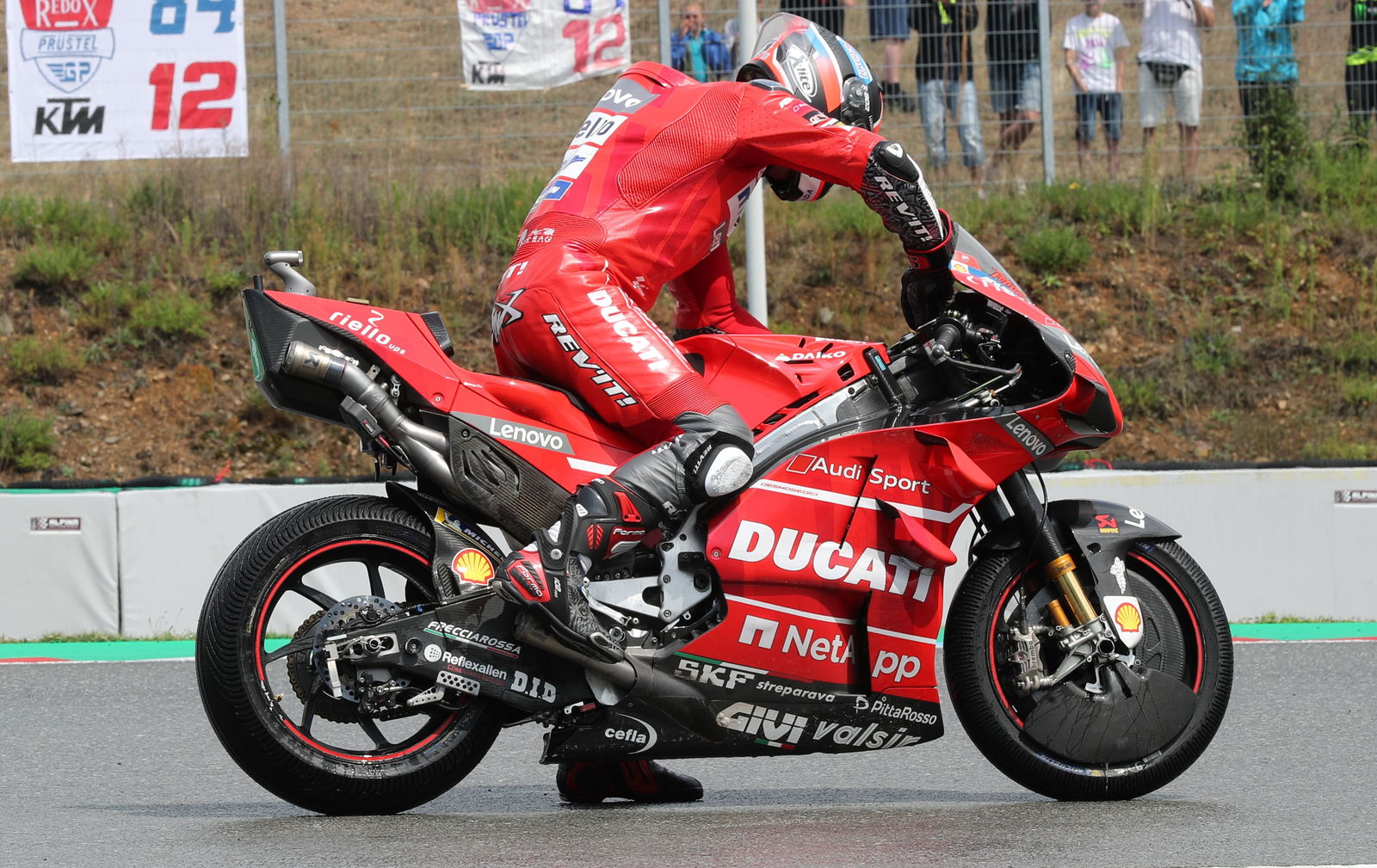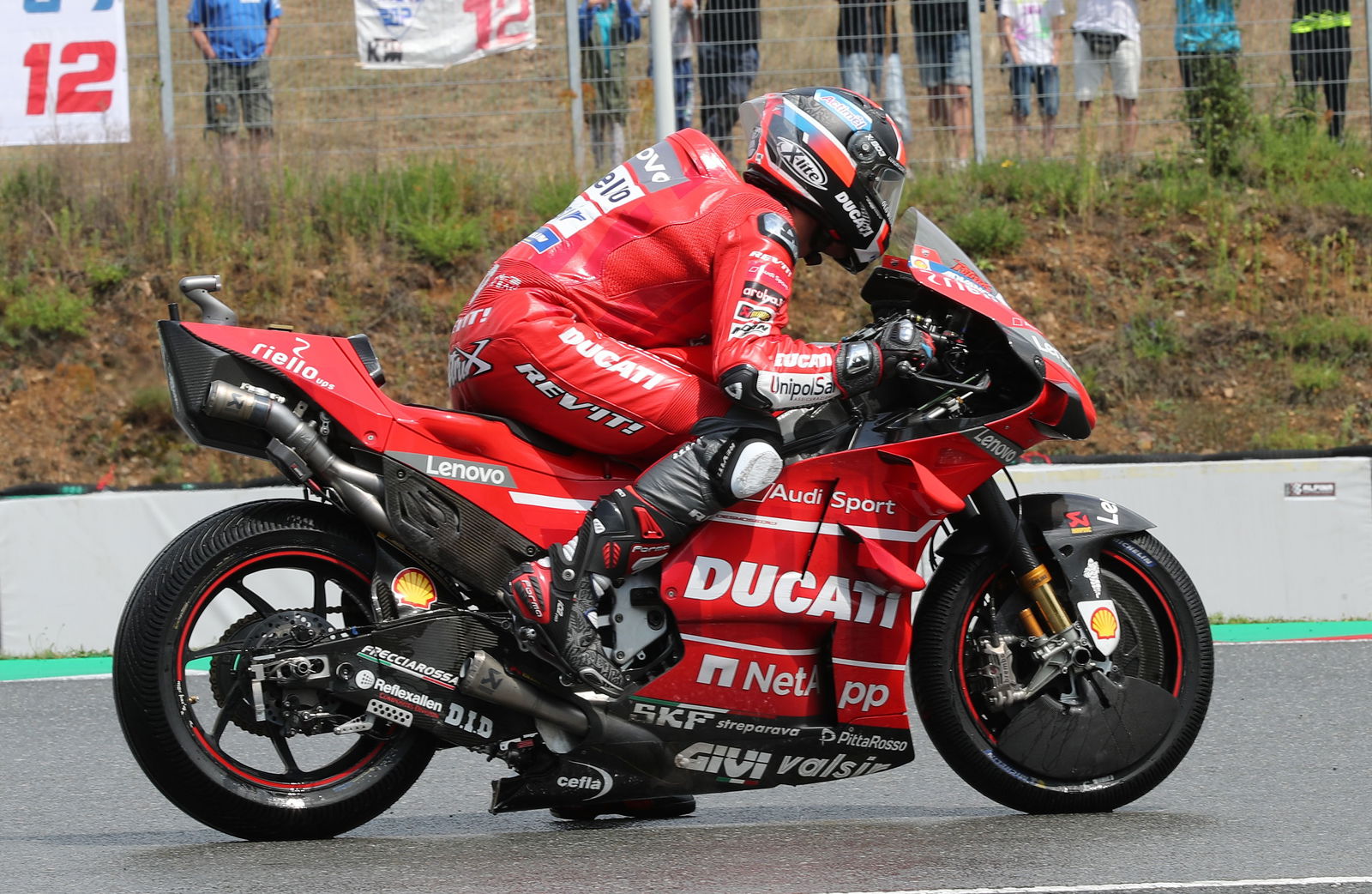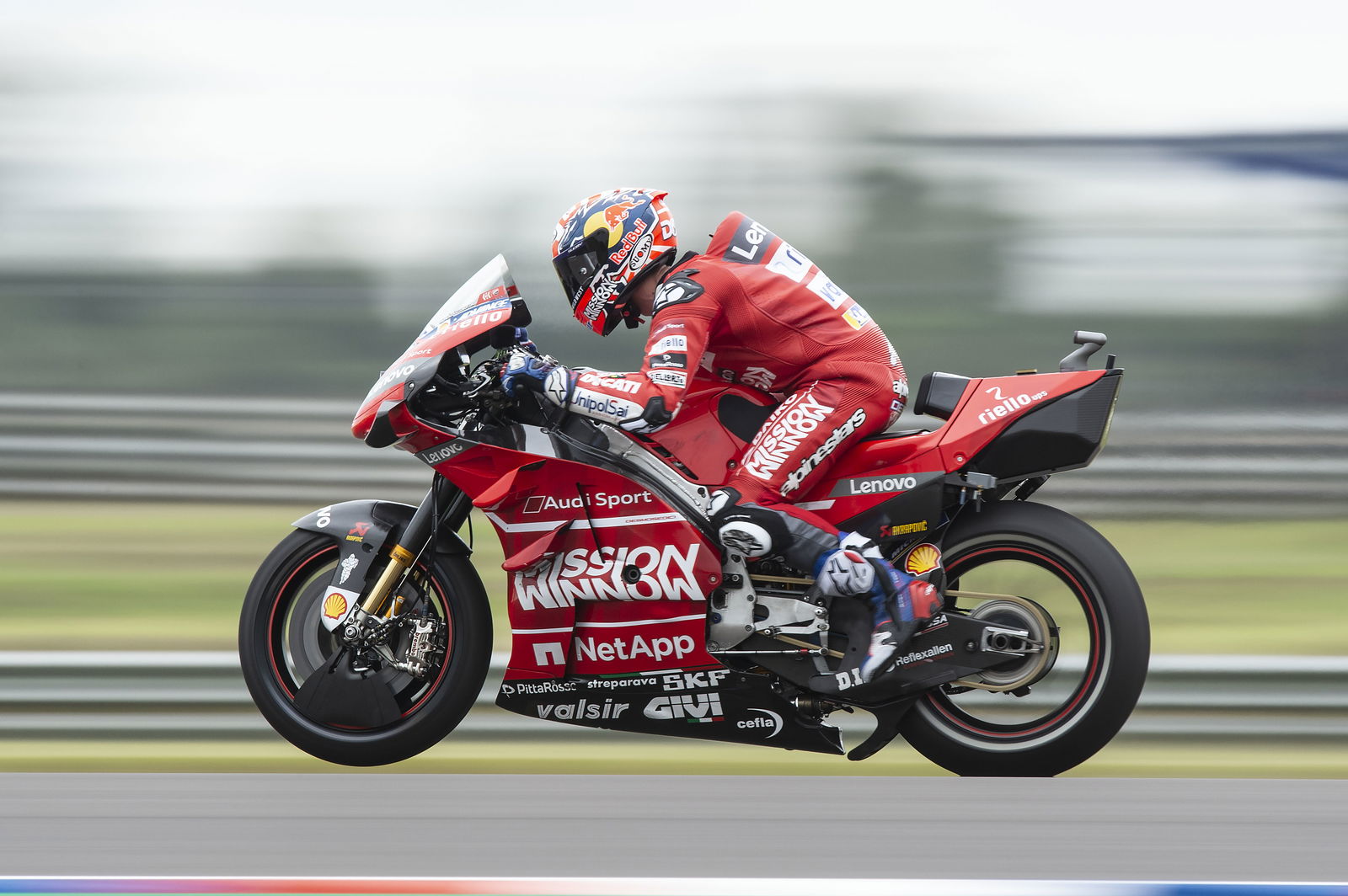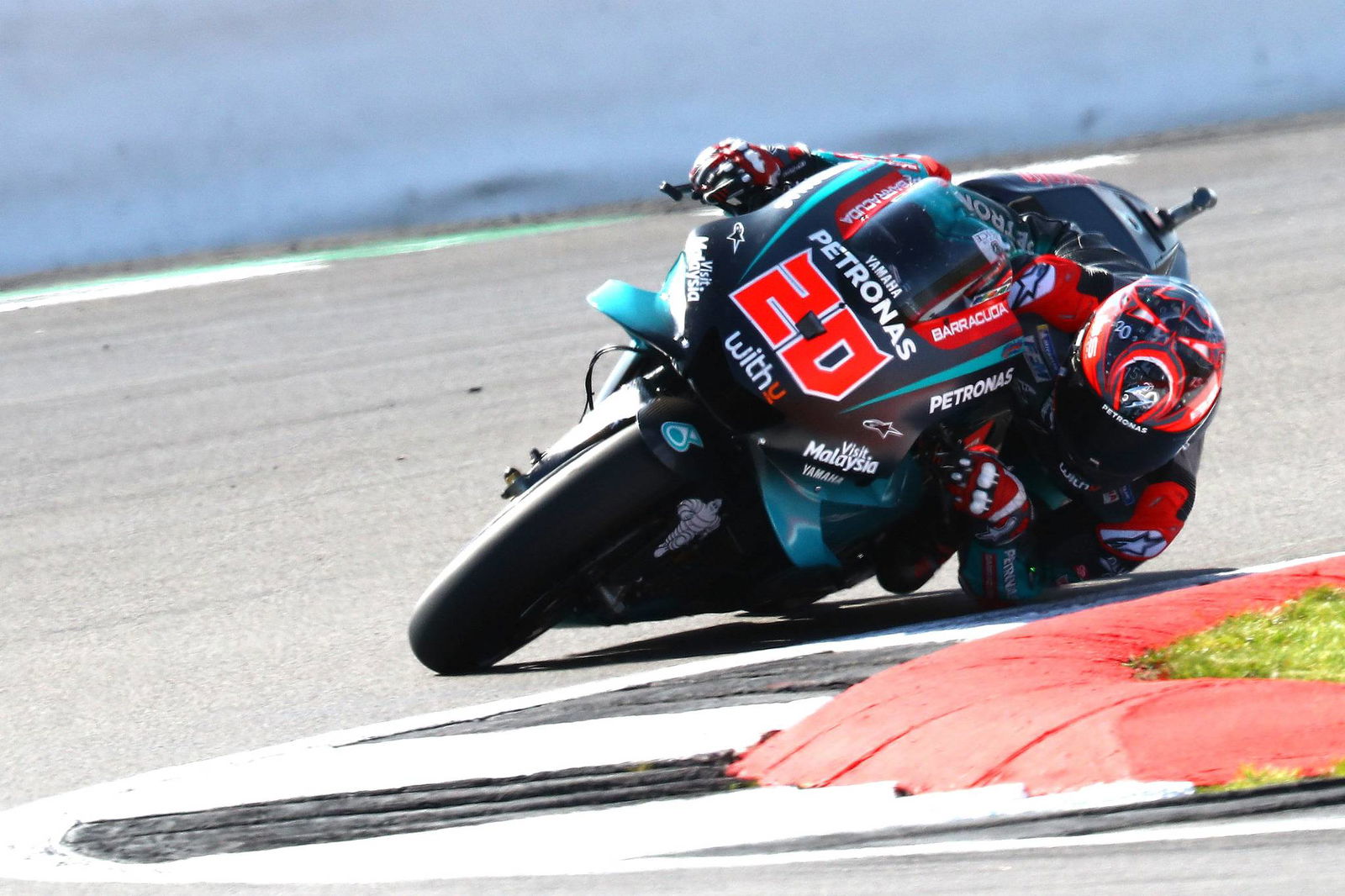The science behind a MotoGP holeshot device
A factory Ducati rider twisting a switch on the dashboard and dropping the rear of the bike before the start of a MotoGP race is now a common sight.
The 'holeshot device' was spotted at the Sepang test in January, but Jack Miller later revealed he'd first used it at Motegi last October.
The system seems to have worked without problem until Silverstone, where Miller's front row qualifying reduced his distance to what is already a fast first corner.

A factory Ducati rider twisting a switch on the dashboard and dropping the rear of the bike before the start of a MotoGP race is now a common sight.
The 'holeshot device' was spotted at the Sepang test in January, but Jack Miller later revealed he'd first used it at Motegi last October.
The system seems to have worked without problem until Silverstone, where Miller's front row qualifying reduced his distance to what is already a fast first corner.
That meant the Australian couldn't generate the braking force (and therefore weight transfer) needed to disengage the device, leaving him to ride the opening turns with the rear still locked down 'like a chopper'.
“My start was good but I couldn’t get my holeshot device back up," Miller said afterwards. "Generally at places like this I don’t use it. It depends [on the track]. At Phillip Island we can’t use it.
"I thought we had enough weight transfer [into turn one] here, but I had doubts. If we’d been a bit further behind on the grid then we could use it. Dovi [row three] was able to get weight transfer no problem. Being so close to the first corner, I barely had to brake."
Miller eventually got the device to release by doing 'a bit of a stoppie'.

Spot the difference: Danilo Petrucci activates the holeshot device during a practice start (top), causing the rear of the bike to drop (below).

That mishap aside, Ducati has clearly decided the risk is worth the reward and other manufacturers have already started to follow suit, Aprilia debuting a holeshot device on its front suspension after the summer break in Brno.
The Japanese manufacturers are not thought to be currently using them, but HRC Technical Manager Takeo Yokoyama pointed out that Alvaro Bautista had one on the front fork of his Gresini Honda in 2012-2014: "We understand the technology and if we need to do it we will, but until now we have not tested anything."
So what's the theory behind a holeshot device, why might you put it at the front or rear of the bike and how much of an advantage can it offer?
To find out more, Crash.net put those questions to MotoGP Director of Technology Corrado Cecchinelli, also former Vice Director General of Ducati Corse…
Crash.net:
Corrado, can you explain why holeshot devices work?
Corrado Cecchinelli:
"The main effect of the holeshot device is to lower the Centre of Gravity. This in turn alters the ratio between the height of the Centre of Gravity (H in picture) and the horizontal distance from the Centre of Gravity to the centre of the rear wheel (B in picture).
"Maximum acceleration depends on this ratio because, on a dry surface with the present tyres, the acceleration limit at the start is the wheelie. Not wheelspin. This is why you want to lower the Centre of Gravity."
Crash.net:
Ducati lowers the rear suspension, Aprilia the front. If you had a choice between the front or rear, wouldn't it be harder to wheelie if you lower the front suspension?
Corrado Cecchinelli:
"The top priority for a holeshot device is just to lower the centre of gravity, by whatever means. But there is also a secondary effect, which you are describing.
"In mathematical terms, if we call the Centre of Gravity height 'H' and the distance from the rear wheel to the CoG 'B', as we have said what matters most is the ratio between B/H.
"The smaller effect by which it is better to lower the front is because you are also doing two other things:
"Firstly, you are pivoting around the rear wheel, which changes the balance of the bike by putting more weight on the front wheel, since the CoG is moving a bit forward, as it is moving down.
"Secondly, because the fork is not vertical, by lowering the fork you are also moving the front wheel backwards, so increasing the static front weight. This is partly compensated for by the fact that the front wheel mass moves backwards, so increasing the chance of wheelie, but the first effect prevails.
"Both of these secondary effects are helpful for less wheelie, but they are of a much smaller order of magnitude compared to lowering the Centre of Gravity.
"For that reason, whether you chose to put the holeshot device on the front or rear depends on more practical reasons, such as the method used to compress and lock the suspension and how much you can compress the suspension.
"For example, you might only be able to compress 50% of the front suspension travel, but 60% of the rear. If the change in Centre of Gravity would be greater using the rear it would outweigh the secondary benefits of using the front suspension.
"It is also normally easier and safer to place the device on the rear because you have more options to work with the suspension, instead of using 'hooks' to hold the front down as you see in motocross. And it is harder to examine the device if you want to keep it a secret from your rivals."
Crash.net:
There is a switch on the dashboard of the Ducati to operate the device before the start. With no electronics allowed, how might it compress and lock the rear suspension in place?
Corrado Cecchinelli:
"For example, there could be a sort of lobe that interferes with the rear link. So you pull the lobe up and it compresses the rear suspension. But it depends on the design of the suspension."

Crash.net:
In your opinion, what sort of performance difference could a holeshot device make?
Corrado Cecchinelli:
"It can make a difference for sure. Let's imagine, to make the maths easy, that the ratio of the horizontal distance from the Centre of Gravity to the contact patch of the rear wheel (B), and the height of the CoG (H) for a MotoGP bike is 1.
"So, for example, the CoG is 0.7m off the ground and also 0.7m ahead of the rear wheel contact patch.
"Your geometric maximum acceleration is when the weight on the front wheel reduces to zero. So, forget the front wheel and think only about the point where the rear wheel is in contact with the ground.
"This is now the pivot point for a downward leverage created by the (vertical) weight of the bike through the CoG that - at the point of wheelie - is being cancelled out by an equal upward leverage caused by the (horizontal) acceleration force through the CoG.
"The maximum amount of acceleration possible to reach the point where the wheelie begins (geometric acceleration limit) comes down to the two measurements mentioned: The horizonal distance from the rear wheel to the Centre of Gravity (B), divided by the height of the Centre of Gravity (H).
"So, in our example, it would be 0.7m/0.7m = 1(g) of maximum acceleration before a wheelie.
"If we assume that a holeshot device at the rear can compress the suspension by 70mm, then the CoG will be lowered by 35mm in turn (assuming the horizontal position of the CoG is midway between front and rear).
"Now the geometric maximum acceleration becomes 0.7m/0.665m = 1.05g.
"But you can probably only use that extra maximum acceleration for a short distance. So a holeshot device can offer a big advantage, for a short time.
"It may help you to be the first rider on your starting row by turn one, for example."
@Petrux9 explodes off the mark with his practice start#QatarGP pic.twitter.com/lh6A8y3nTi
— MotoGP (@MotoGP) March 9, 2019
That sinking feeling: The horizontal lines on the trackside barrier clearly show the back of the Ducati being lowered.
Crash.net:
In which case, are you surprised there are not more people using them?
Corrado Cecchinelli:
"It's been more a tradition in off-road, where the problem of wheelies at the start is greater and you can make a much bigger difference to the CoG height by using a holeshot device, because the suspension stroke is so much longer and bikes are taller and shorter.
"In MotoGP the advantage is smaller than in motocross, so maybe the added weight that you are carrying for all the race, plus the added complication and risk if it goes wrong has always kept manufacturers far from it. At least until competition was not as close as today, when someone is willing to accept higher risks for smaller returns. If the device did not disengage and remained permanently locked, your race would basically be over."
Crash.net:
Jack Miller had a problem with his device failing to disengage at Silverstone. Luckily it unlocked a few corners later. Since the Ducati version is on the rear, it presumably disengages when weight is lifted off the back of the bike under braking?
Corrado Cecchinelli:
"I don’t know how that specific device works but the common principle is by means of a mechanical lock that disengages when a certain condition is met.
"I would say if the lock is on the front, then it shall unlock as soon as the fork travel goes beyond the locked position (e.g. first brake or a bump); if it is on the rear I would say it shall unlock as soon as the suspension gets unloaded, like at the first braking, for instance.
"But of course a number of different principles and systems can be applied, based on load or geometry, without necessarily involving electronics, which is not possible in MotoGP."

Andrea Dovizioso does a practice start.


